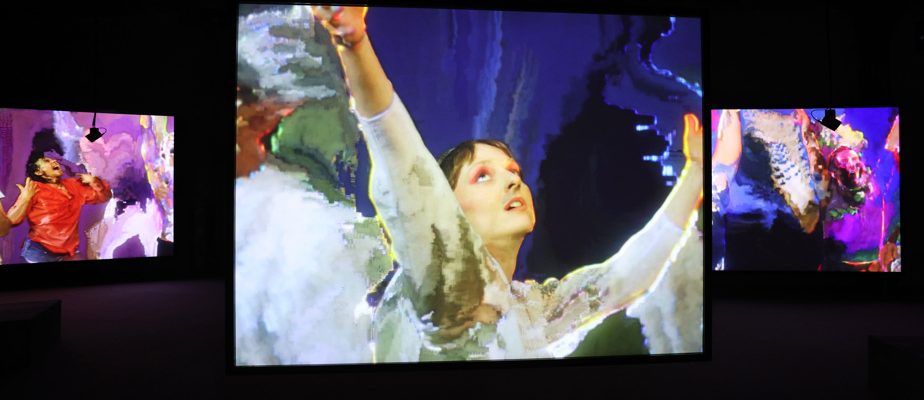The exhibitions signed by John Zeppetelli, outgoing director of the MAC, stood out for the staging of multiple screen installations. The latest project he supports, Phase Shifting Index by Jeremy Shaw, presented at the Darling Foundry, is no exception.
“The MAC was a pioneer in Montreal for expanded cinema,” underlines Zeppetelli, referring to the exhibitions of the father of video art, Bill Viola, or the British artist Isaac Julien, whom the museum hosted in the 1990s and 2000s.
As soon as he took office, the outgoing director of the MAC perpetuated this tradition by putting forward works such as The Visitorsby Ragnar Kjartansson, or even Manifestoby Julian Rosefeldt, which are deployed respectively on 9 and 13 screens in space.
Phase Shifting Index, by Vancouver’s Jeremy Shaw, seems, at first glance, to be in line with this practice.
The winner of the Sobey Art Award in 2016 was familiar with Rosefeldt’s work by the time the installation was presented at the MAC. It was also marked by the moments of synchronicity of the screens during the experience, according to John Zeppetelli.
The seven screens only sync at the end in Phase Shifting Index. In the dark room, we are confronted with fake parascientific documentaries, recalling the aesthetics of technologies of the last century: 16 mm film, VHS, etc. Above all, the work destabilizes us. People move, are interviewed and respond in incomprehensible English.

PHOTO ROBERT SKINNER, THE PRESS
Phase Shifting Index, by Jeremy Shaw, presented at the Darling Foundry
Each screen is independent and presents bodies which become more and more intense as they are viewed. We recognize contemporary dance gestures, training, contact dance or even street dancebut the result seems strange and offbeat.
You must read the accompanying text straight away to understand the full meaning: it is a science fiction story, in the “era of altruistic-peripheral cultures” in the 21st century.e or in the XXIIe century.
The film really comes into its own at the end of the cycle, when screen synchronization begins. The content moves from one image to another until the entirety becomes strobing sound and light, to create collective ecstasy.
So what is the real subject of the work? “It’s the idea of reaching another level of perception or trying to understand what’s happening in our brain when we arrive at this level of perception. It is an attempt to reach a register other than normal reality using movement, explains John Zeppetelli. And the use of the body becomes a vehicle with which we can achieve spiritual ecstasy,” adds the man who acted as curator for this exhibition.

PHOTO ROBERT SKINNER, THE PRESS
Phase Shifting Index, by Jeremy Shaw, presented at the Darling Foundry
Collective work
First presented on the ground floor of the Center Pompidou, the installation Phase Shifting Index was to be hosted at the MAC before the institution closed during the pandemic.
After a dozen meetings between the MAC team and Jeremy Shaw, the layout was able to be refined for the current exhibition: the suspension of the screens, the position of the speakers and subwoofers, the calibration of the sound, the choice of a frontal presentation of the screens, etc.
“It’s a great collective effort! », underlines the director of the MAC who mentions in passing the important contribution of Denis Labelle, the chief technician responsible for this quality of sound and image.
Thus postponed to 2024, Phase Shifting Index finds herself like a free electron in the middle of an annual program at the museum which highlights projects by women artists, starting with the exhibition Velvet Terrorism: Pussy Riot’s Russiaand which continues throughout the year with women volcanoes forests torrents from April 11 as well as with the presentation of works by Alanis Obomsawin.
With the departure of the man who took great interest in broader cinema during his mandate, is this the end of the promotion of this practice at the MAC? At least, everything suggests that considerable transformations will occur thanks to the reorganization of the conservation team. To be continued, therefore, over the coming years.
The exhibition is on until February 25 at the Darling Foundry: https://macm.org/expositions/jeremy-shaw/
The artist will give a free lecture in connection with the exhibition on Tuesday February 13 at 6:30 p.m. at the Darling Foundry.
Visit the conference website
What is expanded cinema?
Since the 1960s and 1970s, the term has been used to name cinematographic practices that go beyond traditional cinema designed for a single screen in a movie theater. The works are deployed in experimental forms, such as multiple screen projections, immersive environments or artistic installations.
Who is Jeremy Shaw?
He is an artist from Vancouver living in Berlin
He has had exhibitions at the Center Pompidou in Paris, MoMA PS1 in New York, Schinkel Pavillon in Berlin and MOCA in Toronto.
He participated in the 57th Venice Biennale, the 16th Lyon Biennale and Manifesta 11 in Zurich
In 2016, he received the Sobey Art Award.
His works are held in several public collections around the world, including those of the Museum of Modern Art in New York, the Center Pompidou in Paris, the Tate Modern in London, and the National Gallery of Canada in Ottawa.
